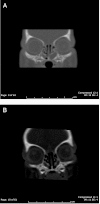Congenital nasolacrimal duct cyst/dacryocystocele: An argument for a genetic basis
- PMID: 22852130
- PMCID: PMC3404478
- DOI: 10.2500/ar.2012.3.0024
Congenital nasolacrimal duct cyst/dacryocystocele: An argument for a genetic basis
Abstract
Embryogenesis of a congenital nasolacrimal duct (NLD) cyst is attributed to the failure of the Hasner membrane of the NLD system to cannulate. Prenatal diagnosis of congenital NLD cysts supports the argument for a developmental error, with a postnatal prevalence of 6%. The role of a genetic basis for this malformation has never been ascribed. We present a set of monozygotic twins with bilateral congenital NLD cysts as an argument for a genetic basis of this entity. A case report and literature review were performed. We present two cases of bilateral congenital NLD cysts occurring in a set of monozygotic twins. Patients were delivered at 37 weeks via cesarean section. The pregnancy was complicated by preterm labor at 33 weeks requiring administration of terbutaline and betamethasone. At presentation, twin A had bilateral eye discharge, erythema, and swelling medial to the medial canthi as well as nasal obstruction. Computed tomography (CT) showed classic bilateral cystic masses in the inferior meatus. The diagnosis of bilateral infected congenital dacryocystoceles was made. Twin B initially presented with only bilateral eye discharge and CT showed a dilated NLD system. Twin B subsequently developed early signs of bilateral dacryocystoceles the following day. Both patients underwent lacrimal probing and endoscopic marsupialization of the dacryocystoceles. Biopsies were consistent with dacryocystocele. Dacryocystocele is a common presentation of unresolved neonatal NLD obstruction. This case report in a set of identical twins is an argument for a genetic basis for the formation of this lesion.
Keywords: Congenital; Hasner; cyst; dacryocystocele; dacryocystorhinostomy; genetic; nasolacrimal.
Conflict of interest statement
The authors have no conflicts of interest to declare pertaining to this article
Figures


Similar articles
-
Awake bedside nasal endoscopy for primary management of neonatal dacryocystoceles with intranasal cysts.Int J Pediatr Otorhinolaryngol. 2019 Aug;123:93-96. doi: 10.1016/j.ijporl.2019.04.043. Epub 2019 May 6. Int J Pediatr Otorhinolaryngol. 2019. PMID: 31085463
-
The association of neonatal dacryocystoceles and infantile dacryocystitis with nasolacrimal duct cysts (an American Ophthalmological Society thesis).Trans Am Ophthalmol Soc. 2012 Dec;110:74-93. Trans Am Ophthalmol Soc. 2012. PMID: 23818736 Free PMC article.
-
Nasolacrimal duct orifice cysts in adults: a previously unrecognized, easily treatable cause of epiphora.Laryngoscope. 2007 Oct;117(10):1830-3. doi: 10.1097/MLG.0b013e31811edd69. Laryngoscope. 2007. PMID: 17690605
-
Congenital Dacryocystocele: A Major Review.Ophthalmic Plast Reconstr Surg. 2019 Jul/Aug;35(4):309-317. doi: 10.1097/IOP.0000000000001297. Ophthalmic Plast Reconstr Surg. 2019. PMID: 30601463 Review.
-
Insights in the treatment of congenital nasolacrimal duct obstruction.Rom J Ophthalmol. 2017 Apr-Jun;61(2):101-106. doi: 10.22336/rjo.2017.19. Rom J Ophthalmol. 2017. PMID: 29450381 Free PMC article. Review.
Cited by
-
Rarely Seen Nasal Congenital Problems Causing Neonatal Upper Respiratory Obstruction: A Case Series.Pediatr Rep. 2016 Mar 31;8(1):6456. doi: 10.4081/pr.2016.6456. eCollection 2016 Mar 31. Pediatr Rep. 2016. PMID: 27114819 Free PMC article.
-
Risk factors for developing congenital nasolacrimal duct obstruction.Saudi J Ophthalmol. 2014 Jan;28(1):58-60. doi: 10.1016/j.sjopt.2013.09.007. Epub 2013 Oct 10. Saudi J Ophthalmol. 2014. PMID: 24526860 Free PMC article.
-
An unusual twinning moment - A rare occurrence of unilateral congenital dacryocystocele in a pair of monozygotic identical twins.Indian J Ophthalmol. 2022 Jul;70(7):2616-2617. doi: 10.4103/ijo.IJO_259_22. Indian J Ophthalmol. 2022. PMID: 35791172 Free PMC article. No abstract available.
-
Bilateral Congenital Nasolacrimal Duct Cyst: A Rare Cause of Nasal Obstruction.Cureus. 2020 Jun 21;12(6):e8742. doi: 10.7759/cureus.8742. Cureus. 2020. PMID: 32714680 Free PMC article.
-
Treatment of congenital nasolacrimal duct cyst: the role of endoscopic marsupialisation.Acta Otorhinolaryngol Ital. 2020 Oct;40(5):377-382. doi: 10.14639/0392-100X-N0759. Acta Otorhinolaryngol Ital. 2020. PMID: 33299228 Free PMC article.
References
-
- Wang JC, Cunningham MJ. Congenital dacryocystocele: Is there a familial predisposition? Int J Pediatr Otorhinolaryngol 75:430–432, 2011 - PubMed
-
- Harris GJ, DiClementi D. Congenital dacryocystocele. Arch Ophthalmol 100:1763–1765, 1982 - PubMed
-
- Mansour AM, Cheng KP, Mumma JV, et al. , Congenital dacryocele. A collaborative review. Ophthalmology 98:1744–1751, 1991 - PubMed
-
- Shashy RG, Durairaj V, Holmes JM, et al. Congenital dacryocystocele associated with intranasal cysts: Diagnosis and management. Laryngoscope 113:37–40, 2003 - PubMed
LinkOut - more resources
Full Text Sources

